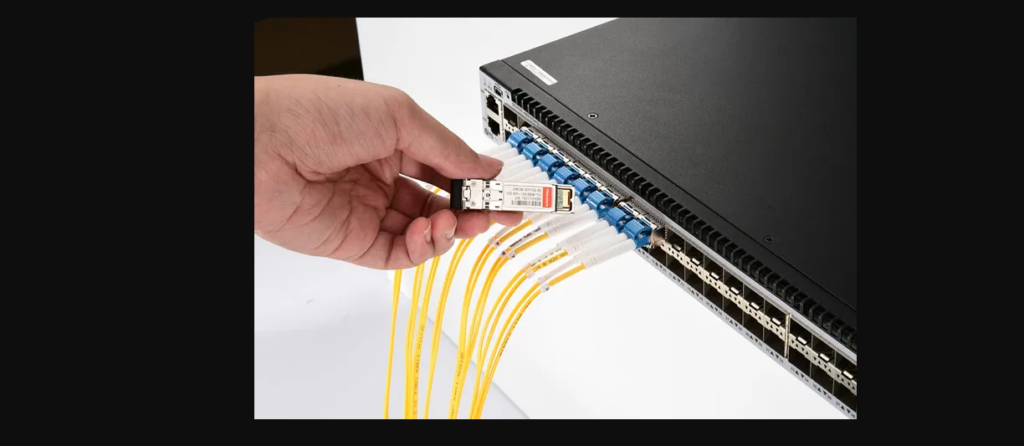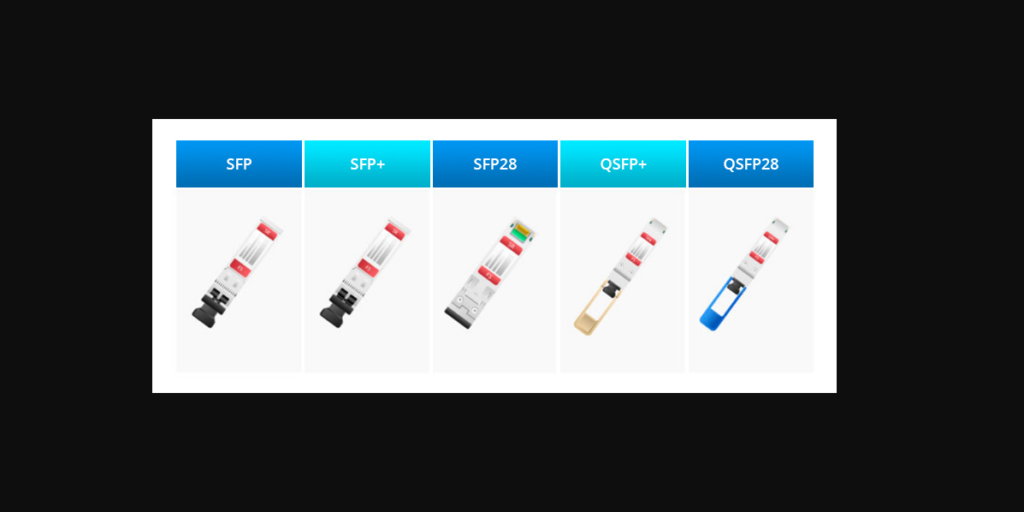In today’s fast-paced world, where efficient and high-speed data transmission is crucial, SFP (Small Form-factor Pluggable) transceivers play a vital role in networking. Whether you’re managing enterprise networks, data centers, or telecom environments, SFP technology is essential for connecting devices seamlessly over long distances. At eTAZ Systems, we are dedicated to providing reliable and efficient networking solutions. This article will break down the key aspects of SFP technology, its applications, and why it’s a critical component in modern networking.
What is SFP?
The Small Form-factor Pluggable (SFP) is a compact, hot-swappable transceiver used in both telecommunications and data communications. It connects networking hardware, like switches and routers, to fiber optic or copper cables. SFPs enable high-speed data transmission over various distances, making them integral to today’s networking infrastructure.
Key Features of SFP:

- Hot-Swappable: SFP modules can be replaced without needing to shut down the entire system, minimizing disruptions.
- Versatility: They work with both fiber optic and copper cables, providing flexibility in network design.
- Range of Transmission: Depending on the type of SFP and cable used, they can support transmission distances from a few meters to several kilometers.
- Speed: SFP modules support speeds ranging from 100 Mbps to 4 Gbps, with SFP+ variants supporting up to 10 Gbps.
Types of SFP Modules:
SX (Short Wavelength):
- Application: For short-distance communication, usually within a building or on a campus.
- Distance: Up to 550 meters.
- Cable Type: Multimode fiber.
- LX (Long Wavelength):
- Application: Ideal for longer-distance communication, such as cross-campus or metropolitan area networks (MANs).
- Distance: Up to 10 kilometers.
- Cable Type: Single-mode fiber.
- ZX (Extended Wavelength):
- Application: Best for long-haul networks, covering distances over 70 kilometers.
- Distance: Up to 80 kilometers.
- Cable Type: Single-mode fiber.
- Copper SFP (1000Base-T):
- Application: Used for short-range networking within a building using standard Ethernet cables.
- Distance: Up to 100 meters.
- Cable Type: Copper (Cat 5e/6).
- CWDM and DWDM SFPs:
- Application: Used in dense wavelength division multiplexing systems, allowing multiple signals to be transmitted simultaneously over the same fiber.
- Distance: Varies, can extend up to 80 kilometers.
- Cable Type: Single-mode fiber.
Advantages of SFP Modules:
- Scalability:
- SFP modules permit arrange directors to effectively update or alter the organize by swapping out the SFP module instep of supplanting the whole switch or switch.
- This makes scaling the network to meet growing demands more cost-effective and less labor-intensive.
- Flexibility:
- The ability to choose between different types of SFP modules (SX, LX, ZX, etc.) depending on network requirements provides high flexibility. This adaptability is especially beneficial in environments where network needs frequently change.
- Compatibility:
- SFP modules are compatible with various vendors and devices, making them a versatile choice for diverse networking environments. This interoperability ensures that eTAZ Systems’ solutions can be easily integrated with existing infrastructure.
- Energy Efficiency:
- SFP modules are designed to be energy-efficient, consuming less power compared to older transceiver technologies. This leads to lower operational costs and contributes to a more sustainable networking environment.
Applications of SFP Modules:
- Data Centers:
- SFP modules are crucial in data centers, where high-speed data transmission is essential. They connect servers, switches, and storage devices, allowing for quick replacement and upgrades, ensuring minimal downtime and maximizing network performance.
- Telecommunications:
- In the telecommunications industry, SFP modules connect different network segments, from local exchanges to metropolitan area networks. The long-distance capabilities of certain SFP types, such as ZX, make them ideal for these applications.
- Enterprise Networks:
- Large corporations use SFP modules to link various parts of their enterprise networks, enabling smooth communication between departments and ensuring strong connectivity across different locations.
- Metro Networks:
- In metropolitan area networks, SFP modules provide high-speed connections between buildings and across cities. The flexibility to switch between different types of SFPs makes it easier to manage and scale these networks.
SFP vs. SFP+ vs. QSFP: Understanding the Differences
While SFP modules are widely used, it’s important to understand their counterparts, SFP+ and QSFP, to make informed decisions.
- SFP (Small Form-factor Pluggable):
- Speed: Up to 4 Gbps.
- Application: Standard networking tasks.
- SFP+ (Enhanced Small Form-factor Pluggable):
- Speed: Up to 10 Gbps.
- Application: High-speed data transmission in environments requiring greater bandwidth.
- QSFP (Quad Small Form-factor Pluggable):
- Speed: Up to 40 Gbps.
- Application: Designed for data-intensive tasks, such as in large data centers.
The choice between SFP, SFP+, and QSFP depends on your network’s specific needs. At eTAZ Systems, we offer expert guidance to help you select the right transceiver for your requirements.
FAQs about SFP Modules by eTAZ Systems
What is an SFP module?
An SFP+ and QSF(Little Form-factor Pluggable) module is a compact, hot-swappable handset utilized to interface switches, switches, and other gadgets to fiber optic or copper cables.
What are the different types of SFP modules?
SFP modules include SX, LX, ZX, Copper SFP, CWDM, and DWDM, each designed for specific distances and cable types.
How do I select the right SFP module for my network?
The right SFP module depends on the required information transmission speed, separate, and cable sort. Our specialists at eTAZ Frameworks can offer assistance you select the fitting module for your network’s needs.
Can SFP modules be utilized with any switch or switch?
Yes, SFP modules are generally compatible with a wide range of switches and routers. However, it’s important to ensure that the SFP module matches your device’s specifications.
What is the difference between SFP and SFP+?
The main difference is the data transmission speed. SFP supports speeds up to 4 Gbps, while SFP+ supports speeds up to 10 Gbps.
Are SFP modules hot-swappable?
Yes, SFP modules are hot-swappable, meaning they can be replaced without shutting down the network device, ensuring minimal downtime.
How long do SFP modules last?
The lifespan of an SFP module depends on usage, environmental conditions, and the quality of the module. Typically, they last several years with proper handling.
What is the maximum distance supported by SFP modules?
The maximum distance varies by type: SX modules support up to 550 meters, LX modules up to 10 kilometers, and ZX modules up to 80 kilometers.
Can SFP modules be used for both fiber optic and copper connections?
Yes, SFP and QSFP modules are available for both fiber optic and copper connections, offering versatility in network configurations.
Why should I choose eTAZ Systems for my SFP needs?
At eTAZ Systems, we offer a wide range of SFP modules tailored to meet the diverse needs of our clients. Our expertise in networking solutions ensures that you receive the best products and services for your specific requirements.
Conclusion
SFP modules are key to modern networking, providing flexible, high-speed connections across various distances. At eTAZ Systems, we understand the importance of reliable and efficient networking solutions. Whether you need help choosing the right SFP and QSFP module or require a complete networking solution, our team is here to assist. With our expertise and commitment to quality, we ensure that your network operates at its best, now and in the future.
For more information on SFP and QSFP modules and how they can benefit your network, contact eTAZ Systems today
